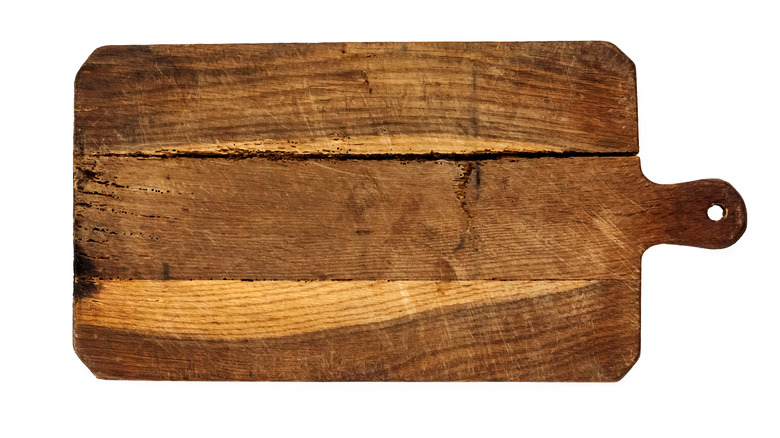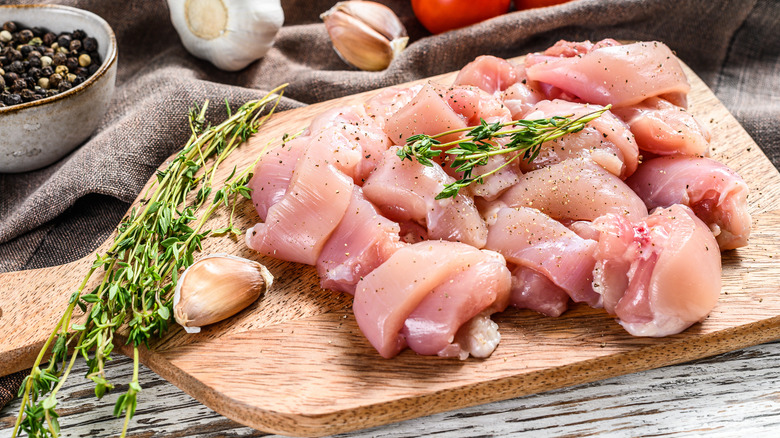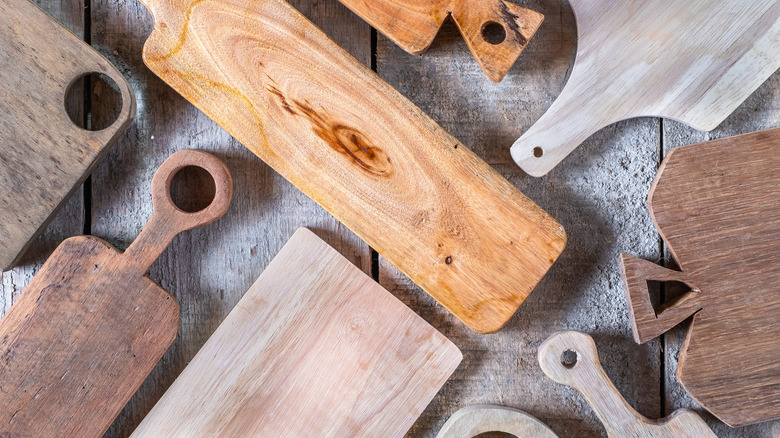Why You Should Stop Using Cracked Wooden Cutting Boards Immediately
When you consider where bacteria are most commonly found in your home, your first thought may be the bathroom. However, another place may have even more bacteria growth, and it will probably make you sick just thinking about it — your kitchen. It's true. Without proper cleaning techniques and maintenance, harmful bacteria and pathogens can hide in different areas of your kitchen. According to a study conducted by NSF, kitchen sponges, countertops, and sinks are all places where germs can collect. Another common place where bacteria can hide is on your cutting boards.
Some may assume that plastic cutting boards are more sanitary than wooden ones. However, this isn't the case. While plastic boards may be easier to clean (since they can be placed in the dishwasher), wooden boards may be the better option. This is because deep grooves, bacteria's favorite place to hide, are less commonly created, per Misen. Also, with proper maintenance, wooden boards will last longer than plastic boards. But when is it time to replace your wooden boards?
When to replace your wooden cutting board
Wooden cutting boards can last quite a long time. According to the Wood Cutting Board Store, with proper care, they typically last five to 10 years. In comparison, plastic boards should be replaced once a year. A reason for their longer lifespan may be their ability to be restored. With the help of sandpaper and wooden board oils, you can fix shallow grooves in your wooden board and extend its lifespan, per the Wood Cutting Board Store.
However, there comes a time when wooden boards need to be replaced. This happens when the wood splits or grooves are too deep to be buffed with sandpaper. You'll want to replace your boards when this happens because bacteria can live inside these grooves and could be transferred to your food.
It's important to note that meat is not the only food that can be contaminated. While, of course, you'll want to be wary about Salmonella when preparing chicken, fruits and vegetables can also carry harmful pathogens, per NCSU. To protect yourself and your family from diseases, you'll want to make sure you thoroughly clean and disinfect your wooden boards after every use. NSF recommends scrubbing your board with soap and water, then disinfecting by soaking it in a bleach mixture. Also, remember that sponges and rags used to clean cutting boards can be contaminated and should also be disinfected regularly.
The best wooden cutting board option
Another way to potentially protect yourself and your family from harmful bacteria are by choosing the best wooden board. Misen says there are two things to consider when selecting the best kind of wood to use. The first is how durable the wood is. Because your knife regularly comes into contact with your wooden board, you'll want to choose a material that doesn't scratch or dent easily. The second thing you'll want to consider is how porous the wood is. You'll want to choose a closed-grained wood, as opposed to an open-grained wood that has more pores. This is because, while bacteria can live in grooves, they can also hide in pores.
Misen also lists the most durable and least porous wood types. These include maple, ash, acacia, cherry, walnut, teak, bamboo, pecan, and beech. Of all these options, Taste Of Home lists maple as the best of the best for a few reasons. Maple is durable, easy to clean, gentle on knives, and bacteria preventing.


